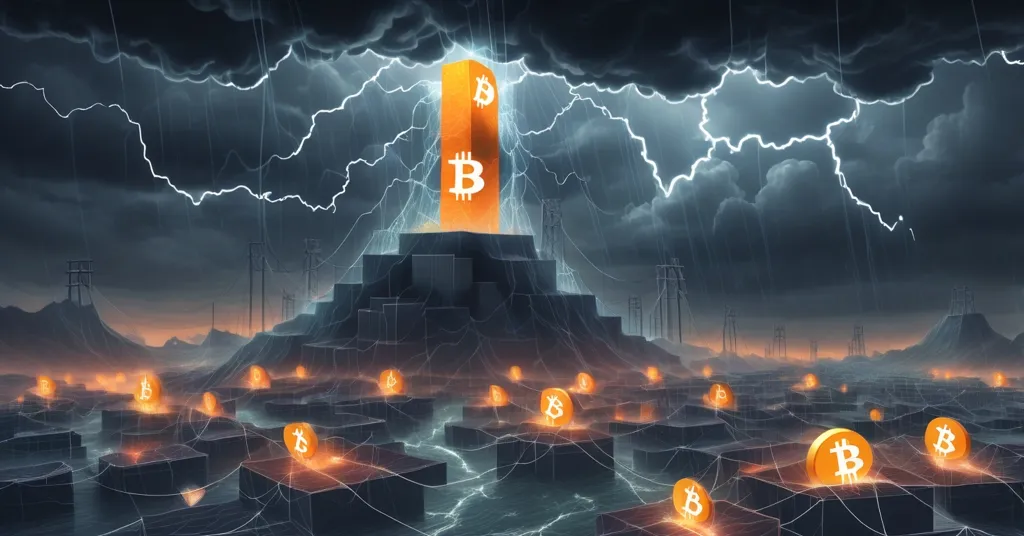US Inflation Spikes with Tariffs: Bitcoin’s Chance in Economic Chaos

US Inflation Climbs as Tariffs Sting: Bitcoin’s Opportunity Amid Economic Turbulence
US inflation has reared its ugly head again, posting its first increase in five months as tariff-driven costs on imported goods seep through the economy. With global trade tensions escalating and central banks scrambling, this economic upheaval could spotlight Bitcoin and decentralized tech as potential lifelines—or expose them to the same stormy markets.
- Inflation Jump: Core CPI rose 0.3% in June, the sharpest climb since January, with an annualized rate nearing 2.9%.
- Tariff Burden: Higher import costs are fueling price hikes, even as retailers hesitate to pass the full load to consumers.
- Crypto Angle: Economic uncertainty often positions Bitcoin as an inflation hedge, but volatility risks loom large.
Breaking Down the US Inflation Surge
The numbers don’t lie, and they’re not pretty. In June, the core Consumer Price Index (CPI)—a measure of price changes excluding volatile items like food and energy—spiked by 0.3%, up from a measly 0.1% in May. This marks the biggest monthly leap since January, and economists surveyed by Bloomberg now project an annualized core inflation rate of 2.9%, the first acceleration this year. What’s behind this? Tariffs, those pesky taxes on imported goods, are driving up costs for businesses, who are starting to pass the pain along. Think everything from steel to sneakers getting pricier at the wholesale level. Retailers, though, are playing it cautious, reluctant to slap higher prices on consumers already feeling the pinch of a cooling job market. For more on this trend, check out the detailed analysis of US inflation and tariff impacts.
Retail sales data for June paints an even grimmer picture—barely any growth after two straight months of declines. This isn’t just about fewer trips to the mall; it’s a key signal for second-quarter GDP estimates. If consumers keep their wallets shut while tariff-driven price hikes pile up, we’re staring at sustained inflation through 2024. The Federal Reserve, with its next policy meeting slated for July 29-30, isn’t taking this lightly. They’re holding off on cutting interest rates, wary of fueling more price growth with persistent inflation risks tied directly to these trade policies. When import taxes inflate the cost of everyday goods, slashing rates could turn a smoldering problem into a full-blown inferno.
Global Fallout from Tariff Shockwaves
This isn’t just a US headache—tariffs are a blunt instrument sending shockwaves worldwide. In Canada, June inflation figures are pivotal ahead of the Bank of Canada’s rate decision on July 30, with analysts at RSM US pegging recession odds at a worrying 55%. China’s upcoming data on GDP, retail sales, and trade will reveal the true sting of American tariffs on their economy. Over in Japan, inflation is expected to ease to 3.3%, yet this still pressures their central bank to tighten policy amid a shaky recovery. The UK isn’t faring much better, grappling with stubbornly high inflation despite cooling wage growth, leaving the Bank of England torn on rate cuts. Meanwhile, G20 finance ministers are convening in South Africa, desperately trying to keep trade standoffs from spiraling into economic warfare. For a broader look at these dynamics, see the report on global inflation trends and central bank responses.
Adding to the mess, a new wave of US tariffs announced by former President Donald Trump kicks in on August 1. We’re talking 30% tariffs on goods from Mexico and the EU, with rates as steep as 50% for sectors like copper, and varying levies between 20% and 50% for partners like Canada and Japan, according to Yahoo Finance. This follows a temporary reprieve on “reciprocal” tariffs in April that briefly steadied markets. Investors are clinging to hopes of trade agreements with allies like Japan and South Korea to dodge harsher rates, but the outlook is murky. Japan is reportedly reassessing its reliance on US security ties, and the EU is mulling retaliatory measures, per Jacob Funk Kirkegaard of Bruegel. For specifics on these policies, read more about Trump’s new tariff plans. Anthony Saglimbene, Chief Market Strategist at Ameriprise Financial, didn’t mince words on the stakes:
“That’s what the market has built in. If we don’t get that, then I think there is probably some risk that we would see higher near-term volatility if the White House implements some of these aggressive tariff measures.”
In plain terms, if diplomacy flops, markets could throw a fit—and that turbulence won’t stay confined to stocks and bonds.
Bitcoin and Crypto: Hedge or Hazard?
So, where does this leave Bitcoin and the broader crypto space? Economic uncertainty, rising inflation, and fiat currency devaluation have often pushed investors toward decentralized assets. Bitcoin, frequently hailed as “digital gold” due to its fixed supply of 21 million coins, saw notable surges during past trade wars. Take the US-China tariff clashes of 2018-2019—Bitcoin rallied over 200% from its yearly low to high, per CoinGecko data, as investors sought a hedge against fiat erosion. The reasoning is straightforward: when central banks are caught between runaway inflation and recession fears, and paper money loses buying power, a borderless, censorship-resistant asset starts looking like a solid bet. Learn more about this concept through the definition of Bitcoin as an inflation hedge.
But don’t pop the champagne just yet. Volatility in traditional markets often bleeds into crypto. If tariff wars spark a stock market plunge or a deeper economic slump, Bitcoin could take a hit alongside riskier assets before any rebound. Look at the 2020 COVID crash—BTC initially tanked 50% in a matter of days as panic gripped Wall Street, even though inflation fears later drove it to new highs. Plus, government crackdowns on crypto tend to tighten when economic control slips—tariff revenue might pad budgets, but it could also mean harsher oversight on decentralized finance. For Bitcoin maximalists, this centralized chaos is the ultimate case for a system outside government clutches. Yet, volatility reminds us we’re still tethered to the old financial beast—for now. For a deeper dive into this dynamic, explore how tariffs impact cryptocurrency market volatility.
Altcoins and other blockchain protocols also have skin in the game, filling niches Bitcoin doesn’t aim to cover. Ethereum, for instance, powers decentralized finance (DeFi) platforms like Uniswap and Aave, where users can lend or borrow without banks, often earning yields far above traditional savings accounts. During economic squeezes, such tools offer alternative financial rails—think small businesses dodging high import fees by settling cross-border payments via stablecoins. Then there’s blockchain’s potential to disrupt tariff-laden supply chains directly. Projects like VeChain or IBM’s TradeLens use distributed ledgers to track goods transparently, potentially slashing costs and sidestepping trade barriers. These aren’t just theoretical; they’re early steps toward a world where centralized trade policies hold less sway.
Central Bank Chaos Fuels Decentralization’s Case
Zooming back to central banks, their scattered responses to tariff shocks highlight systemic cracks. While the Fed sticks to a cautious, restrictive stance—potentially eyeing cuts in September or December if labor markets crater or inflation tops 3%, per RSM US—the European Central Bank and Bank of England are leaning toward modest 25 basis-point cuts to buffer their sluggish economies. The Bank of Japan wrestles with tightening amid falling inflation, and China’s central bank may ease further to counter domestic debt and trade hits. This lack of sync isn’t just policy divergence; it’s a glaring sign of centralized systems buckling under pressure. For insights into Bitcoin’s role here, consider this perspective on Bitcoin’s decentralization during economic uncertainty.
For Bitcoin purists, this is a neon-lit “told you so.” A fixed-supply asset immune to money printing looks golden when fiat systems falter. If effective accelerationism—pushing tech to fix broken systems faster—is the goal, then Bitcoin and blockchain are the turbochargers we need right now. Even so, I’ll tip my hat to altcoins. Ethereum’s smart contracts and DeFi tools, or even Ripple’s cross-border payment systems, offer flexibility Bitcoin’s store-of-value focus doesn’t. They’re complementary cogs in a broader financial revolution, tackling niches from lending to trade logistics that BTC shouldn’t—and doesn’t—touch.
Key Questions on Inflation, Tariffs, and Crypto
- What’s behind the recent US inflation spike?
Tariff-driven costs on imported goods are the main culprit, pushing core CPI up 0.3% in June, with projections of a 2.9% annualized rate signaling a persistent trend. - Why is the Federal Reserve avoiding rate cuts?
Persistent inflation linked to tariffs has the Fed on guard, hesitant to stimulate more price growth ahead of their late July policy meeting. - How are global economies impacted by US tariffs?
Canada faces a 55% recession risk, China’s trade data will expose tariff damage, Japan’s central bank is under pressure despite falling inflation, and the UK battles high prices, all while G20 leaders scramble for solutions. - Could new tariffs spark market chaos?
Yes—if trade agreements with allies like Japan fail, steeper tariffs from August 1 could trigger significant volatility, as cautioned by strategists like Anthony Saglimbene. - Is Bitcoin a reliable shield against this economic uncertainty?
It’s a compelling hedge against inflation and fiat decline, with historical rallies during trade wars, but it’s not immune to broader market downturns, so expect bumps. - What role do altcoins play amid trade tensions?
Platforms like Ethereum drive DeFi and smart contracts, offering financial tools outside traditional systems, while blockchain projects like VeChain could bypass trade barriers with transparent supply chains. - How can blockchain mitigate trade war fallout?
By enabling decentralized cross-border payments and supply chain tracking, blockchain tech offers paths to cut costs and dodge tariffs, though adoption remains in early stages.
Unpacking the Real-World Sting of Tariffs
For the uninitiated, tariffs are taxes slapped on imported goods, often to shield domestic industries or play hardball in geopolitics. When the US imposes a 30% tariff on goods from Mexico or a 50% levy on copper, American businesses pay more for those imports. That’s why your next gadget or car part might cost extra, even if retailers are stalling on price hikes to avoid scaring off customers in a shaky job market. Bloomberg economists warn this delay won’t hold—expect inflation to ramp up as companies run out of room to absorb costs. Picture a small business owner importing materials for handmade goods: higher tariffs mean slimmer margins, maybe even layoffs. Could they turn to crypto payments to cut bank fees on international deals? It’s a long shot today, but a seed of disruption worth planting. For community opinions on this, peek at discussions around inflation, tariffs, and Bitcoin’s role.
Geopolitical Stakes and Crypto’s Long Game
Beyond economics, the geopolitical stakes are sky-high. The G20 summit in South Africa isn’t just bureaucrats sipping coffee—it’s a last-ditch effort to stop trade spats from becoming full-on economic warfare. With allies like Japan and Canada questioning US ties, and the EU gearing for countermeasures, we’re not just facing price hikes but a potential reshuffle of global power. For crypto, this chaos could speed up adoption in regions hungry for financial independence from US-dollar dominance. Imagine nations or firms using blockchain for settlements to skirt tariff-heavy trade routes. It’s not mainstream yet, but the seeds are there, and projects like RippleNet are already testing these waters. Curious about broader impacts? Explore thoughts on how tariffs influence cryptocurrency markets.
Cutting Through Market Hype and Hard Truths
One last reality check: anyone hawking “Bitcoin to $100K by year-end” predictions amid this mess is peddling snake oil. We’re here to drive adoption and deliver unfiltered truth, not shill fantasies. Inflation and trade tensions bolster Bitcoin’s case as a store of value, but timing crypto markets is a fool’s game, especially with traditional volatility spilling over. Historical patterns show BTC thriving long-term during fiat crises, yet short-term dips are inevitable when panic hits. For a recent update on the inflation numbers, see this report on US inflation rising for the first time in five months.
Ultimately, this tariff-inflation saga underscores why decentralization matters. Bitcoin and blockchain aren’t instant fixes for skyrocketing grocery bills or trade wars, but they’re a parallel track—a way to opt out of centralized control one step at a time. As economic turbulence brews, the crypto space has a shot to prove its mettle, not as a get-rich-quick gimmick, but as a radical rethink of money and power. Whether it delivers depends on weathering the storm ahead—and that’s no small gamble.



